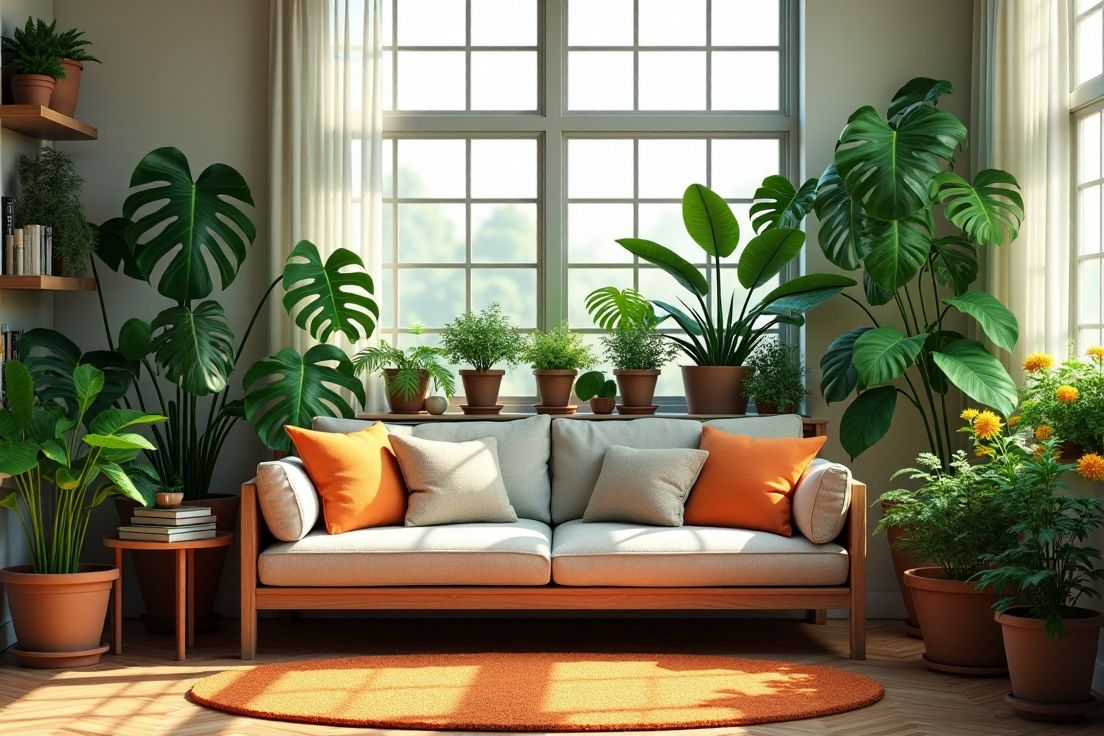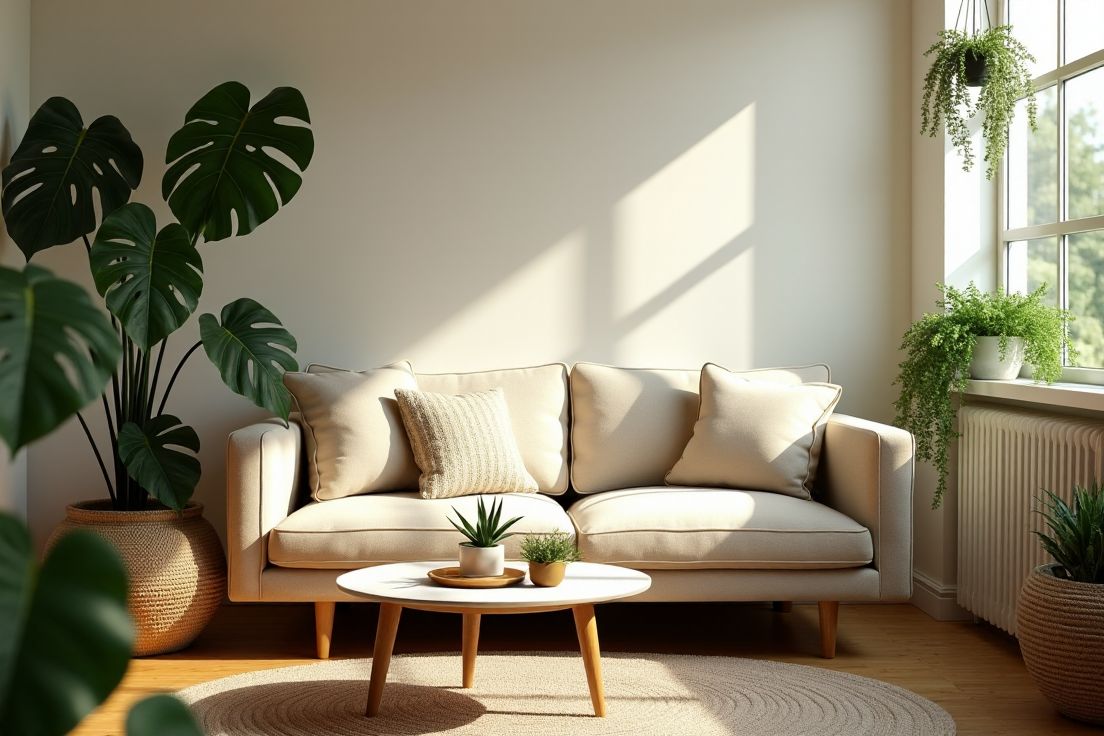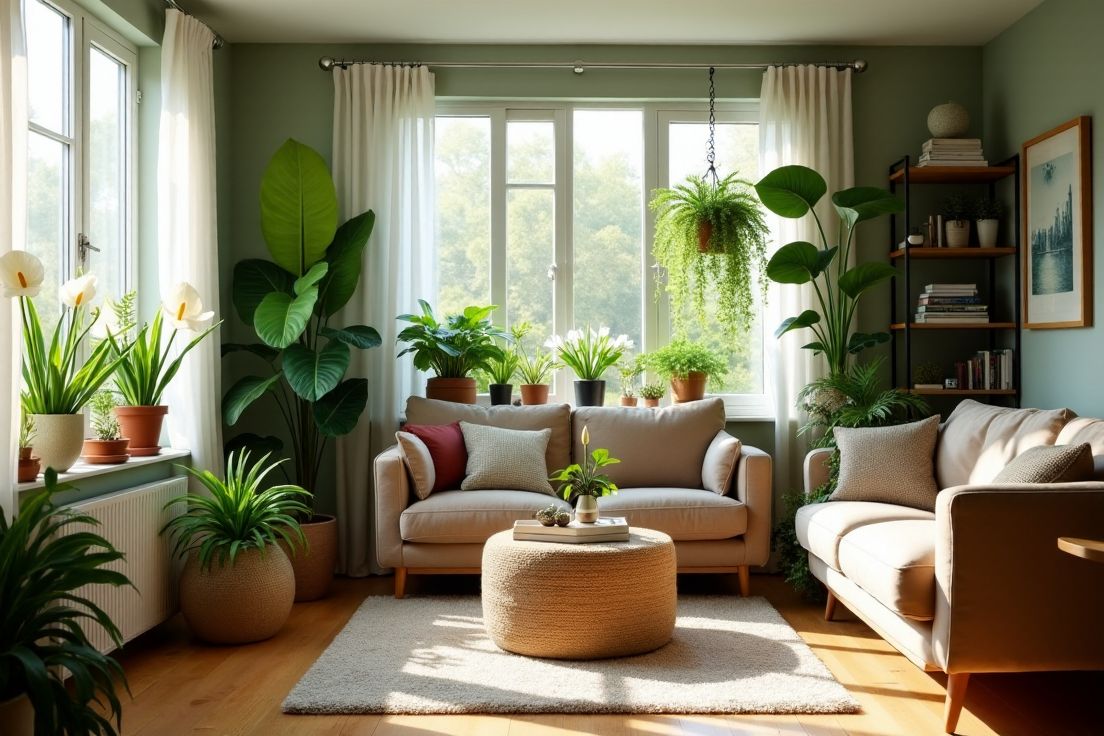The living room is often the heart of the home, where family and friends come together to relax and enjoy each other’s company. Creating the perfect atmosphere in this space is essential for comfort and enjoyment.
In this post, we will explore the key elements that make up your living room environment. From colors and layouts to lighting and plants, understanding how each factor contributes to the overall feel can help you design a welcoming and inviting space.
Get ready to discover tips on enhancing your living room, making it both beautiful and functional. Let’s dive in!
Exploring the Atmosphere of Your Living Room

Understanding the living room environment is crucial for creating a space that feels inviting and comfortable. The colors you choose for the walls can set the mood of the room. Light neutral shades often make a space feel larger and airier, while deeper colors can create a cozy, intimate atmosphere.
Layout also plays a key role.
An effective arrangement allows for easy movement and conversation. Placing furniture in a way that encourages interaction, like positioning sofas and chairs to face each other, can enhance the space’s livability.
Natural light is another important factor. Large windows can brighten the area and make it feel more open.
If your living room lacks natural light, consider adding mirrors to reflect light and make the room feel brighter.
Textures and materials contribute to the overall feel as well. Mixing different textures, such as soft throws and sleek furniture, can create an interesting visual dynamic. Plants can add life and warmth, improving air quality and bringing a touch of nature indoors.
Factors to Consider for Plant Growth in Living Rooms
Choosing the right plants for your living room involves several important factors. First, consider the light levels in the room. Different plants thrive under various lighting conditions, from bright direct sunlight to low indirect light. Knowing how much light your space receives will help you make a better selection.
Next, evaluate the humidity levels. Some plants prefer humid conditions, while others are more tolerant of dry air. If your living room is air-conditioned or has heating, this may impact the moisture levels, so aim to pick plants that will do well in your specific environment.
The size of the pots and the plants themselves should also be part of your planning.
Large plants can create a stunning focal point, while smaller ones can complement the decor without overwhelming the space. Additionally, ensure that the pots have proper drainage to prevent overwatering, which can lead to root rot.
Its also beneficial to think about care requirements. Some plants may need regular watering and fertilization, while others are more self-sufficient.
Matching the maintenance needs of the plants with your own lifestyle is key to ensuring they thrive.
Finally, consider the aesthetic appeal of the plants and how they fit with your living room decor. Look for colors, shapes, and sizes that enhance your space, adding warmth and personality to the overall design. Choosing plants that resonate with your style will enhance your living room atmosphere.
Optimal Light Conditions for Living Room Plants
For the healthiest living room plants, understanding light conditions is vital. Different plants have varied light requirements. Some thrive in bright, direct sunlight, such as succulents and cacti. These plants do best near south-facing windows where they can soak up maximum rays.
In contrast, many tropical plants, like pothos and peace lilies, prefer bright, indirect light. These plants can flourish in spaces with filtered sunlight or dappled light, perhaps from sheer curtains.
Low-light areas require special consideration. Plants such as snake plants and ZZ plants can survive in these conditions, making them excellent options for rooms with limited sunlight.
Here is a table displaying various tropical plants and their light preferences, which can help in selecting suitable plants for different lighting conditions in indoor spaces.
| Plant Name | Light Preference | Notes |
|---|---|---|
| Pothos | Bright, Indirect Light | Thrives in filtered sunlight. |
| Peace Lily | Bright, Indirect Light | Enjoys dappled light and can bloom with adequate light. |
| Snake Plant | Low Light | Very resilient and requires minimal care. |
| ZZ Plant | Low Light | Can tolerate very low light and infrequent watering. |
| Philodendron | Bright, Indirect Light | Prefers to be in low to medium light; avoid direct sunlight. |
| Spider Plant | Bright, Indirect Light | Tolerates a range of light conditions but flourishes in bright light. |
It’s essential to rotate these plants occasionally to ensure all sides receive light, helping them grow evenly.
Beware of placing plants too close to windows where harsh afternoon sunbeams might scorch their leaves. If you’re concerned about too much sunlight, using sheer window treatments can diffuse the light effectively. Monitoring your plants and adjusting their positions based on their response to the light in their spots is a great way to keep them thriving.
Choosing the Right Plant Size for Your Space
Choosing the appropriate size for your plants can significantly impact the look and feel of your living space. Large plants, such as fiddle leaf figs or rubber plants, often serve as striking focal points. They can fill empty corners and add height, creating a more dynamic and interesting atmosphere. However, be cautious with oversized plants in smaller rooms, as they can overwhelm the area and make it feel cramped.
For compact spaces, smaller plants like snake plants or succulents can bring life without taking over. These can be placed on shelves, tables, or even in hanging planters, allowing you to utilize vertical space effectively. Grouping smaller plants together can create an appealing arrangement and is great for decorating tabletops or windowsills.
When considering the right size, also think about the growth potential of the plant.
Some species, like monstera, can grow significantly over time and may require more space as they mature. Be mindful of where you place them to avoid needing to relocate them frequently.
Additionally, the plant’s size should relate to your furniture and other decor elements. A towering plant next to a low coffee table might create a visually unbalanced effect.
Enhancing Your Living Room Atmosphere

Creating a welcoming living room involves a careful look at your surroundings. The arrangement of furniture and decorations can impact how the space functions. For instance, if you have a low coffee table, consider the height of the surrounding seating. This balance can help maintain a sense of harmony in the room.
Consider how the various design elements work together. Choosing a common theme or color palette can tie the space together, making it feel cohesive. This consideration extends to your choice of houseplants too. Plants can accentuate the existing decor or provide a lively contrast, so think about where they fit in your overall design.
Temperature is also a key aspect of comfort. When selecting plants, ensure they are suitable for the temperature range in your living room. Avoid placing heat-sensitive plants near radiators or heating vents, as this might stress them.
Another point to think about is the flow of your living room.
If paths between furniture are blocked, the area may feel cramped. Creating open pathways helps maintain a sense of spaciousness. Ensure that plants do not obstruct these routes but rather enhance the atmosphere without overwhelming visitors.
Sounds can shape your living room experience too.
Light Conditions in Your Living Room
When considering light conditions in your living room, it’s essential to assess both natural and artificial light sources. The direction of windows influences how light enters the space. South-facing windows typically provide the most sunlight, making them ideal for plants that thrive in bright light. East-facing windows offer gentle morning sunlight, while west-facing spaces capture the warm glow of the afternoon, suitable for a variety of plants.
North-facing windows, however, can present challenges, as they often receive less direct light. In these areas, opting for low-light tolerant plants becomes crucial.
Artificial lighting also plays a pivotal role in maintaining plant health. Using full-spectrum bulbs can mimic sunlight and support growth during shorter days.
Positioning lights close to your plants ensures they receive adequate illumination. Additionally, consider the light’s placement and type; overhead fixtures may not reach lower plants effectively, while floor lamps can offer focused light for potted plants on tables or stands.
Monitoring how light changes throughout the day will inform your choices. If certain spots get too bright, adjusting the positioning of your plants or using sheer curtains can help filter the light.
Regular observation of plant health will guide you in making any necessary adjustments for optimal growth.
Appropriate Humidity Levels for House Plants
Humidity plays a vital role in the overall health of houseplants. Different species have varying needs when it comes to moisture in the air. Tropical plants, for instance, thrive in higher humidity levels, often around 50-70%. These plants can suffer in dry conditions, leading to browning leaf tips or slow growth.
Conversely, succulents and cacti are better suited for lower humidity, typically preferring levels around 30-40%. They can easily rot if exposed to excessive moisture. Understanding these needs is crucial when selecting plants for your living room.
If you notice that your living room is overly dry, especially during winter months when heating systems are in use, consider increasing humidity levels.
You can use a humidifier, place water trays with pebbles near your plants, or mist them regularly. Grouping plants together can create a microenvironment with higher humidity, benefiting those that enjoy moist air.
Monitoring humidity is key. A simple hygrometer can help track the moisture levels in your space.
Keeping your plants humidity needs in mind while arranging your living room ensures they flourish in their environment.
Choosing Plants Based on Room Size
When it comes to selecting plants for your living space, room size is an important consideration. Larger areas can accommodate taller plants that draw the eye upward, such as palm trees or fiddle leaf figs. These can create a striking focal point, adding dimension to the room. However, in a small living area, oversized plants can easily overwhelm the space, making it feel cramped.
For cozy settings, opt for smaller plants like succulents or peace lilies. They can liven up surfaces without taking up too much room. Placing these plants on shelves or tables can help maximize vertical space. Combining several smaller plants can also create an inviting display without overpowering the decor.
It’s essential to think about the scale of your furniture and other elements. A tall plant next to a short couch can create imbalance, while a well-proportioned setup enhances harmony in the space. Likewise, consider the plant’s growth potential. Some plants may grow significantly, altering the dynamics of the room.
Understanding Your Living Room Environment

When assessing your living room, consider elements like color, texture, and layout. The colors on the walls influence how spacious or cozy the space feels. Warm tones can make the room feel inviting, while cool colors might create a calming effect. Beyond color, the arrangement of furniture is essential for both function and flow.
Ensure that pathways remain clear to promote comfort and movement.
Pay attention to lighting, too. Natural light brightens the room, enhancing the atmosphere. If your living room gets limited sunlight, placing mirrors can help bounce light around, creating a more open feel.
Incorporating various textures can also enhance the experience; for instance, soft cushions paired with sleek furniture create a balanced aesthetic.
Additionally, think about the role of plants in your living room. They can act as decorative elements while improving air quality and adding a natural touch. Choose plant varieties that fit well with the surrounding design.
Consider how plant sizes relate to your furniture a large plant can stand out as a focal point or fill an empty corner, while smaller plants can add details without overwhelming the space.
Finally, your living rooms temperature and humidity can greatly affect both your comfort and your plants health. Ensure that plants are kept in areas suited to their needs, avoiding extremes that may cause stress. By understanding and optimizing these elements, you can create a living room environment that is both enjoyable and vibrant.
Frequently Asked Questions
This FAQ addresses common questions related to creating a comfortable and inviting living room atmosphere, with a focus on lighting, plants, and overall design elements.
What are the best colors to use in my living room?
Light neutral shades can make a space feel larger and airier, while deeper colors create a cozy and intimate atmosphere. It’s essential to choose colors that resonate with your personal style and the mood you want to achieve.
How can I maximize natural light in my living room?
To maximize natural light, ensure that windows are unobstructed and consider using mirrors to reflect light. Using sheer curtains can also help diffuse harsh sunlight, creating a brighter space.
What types of plants are suitable for low-light conditions?
Plants such as snake plants and ZZ plants are excellent options for low-light areas. These species can tolerate minimal light and are generally easy to care for, making them perfect for rooms without much natural sunlight.
How do humidity levels affect houseplants?
Humidity levels are crucial for plant health. Tropical plants thrive in higher humidity, while cacti and succulents prefer lower humidity. It’s essential to choose plants that match the moisture levels in your living room.
What factors should I consider when choosing plant sizes for my living room?
Consider the scale of your furniture and available space. Large plants can serve as focal points, while smaller plants complement decor without overwhelming the area. It’s also essential to think about the growth potential of the plants.
How can I improve the flow of my living room?
Ensure that pathways between furniture are clear and unobstructed. Arranging seating to encourage conversation and keeping traffic areas open can enhance the overall livability of your living room.
What is the importance of furniture arrangement in a living room?
Furniture arrangement affects both the functionality and comfort of the space. A well-planned layout encourages movement and interaction, while maintaining balance and harmony in the design.